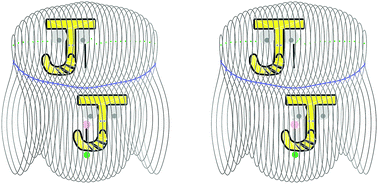Topology of the magnetically induced current density and proton magnetic shielding in hydrogen bonded systems†
Abstract
It is pointed out that a common feature of the current density induced in hydrogen bonded systems X–H⋯Y–Z by a magnetic field perpendicular to the H-bond is a continuous stagnation line made of (2,0) saddle points. The saddle line cuts the H-bond almost perpendicularly near the bond critical point (BCP). This implies the confinement of the current density within three basins of current delimited by two separatrices formed by all the asymptotic trajectories originating and terminating at the saddle points. Then, the perpendicular nuclear magnetic shielding (and magnetizability) is partitioned into three contributions: one for the X–H fragment, one for Y–Z, and an external one surrounding the former two. This permits us to ascertain that the largely decreased perpendicular proton magnetic shielding is determined by a local effect inside the X–H domain due, ultimately, to a minimal loss of electron charge density around the hydrogen. A drop as small as 2–3% of an electron within a restricted region around the hydrogen nucleus causes a deshielding effect as large as 4.5–5 ppm, namely 20% of the free-molecule shielding, thus making NMR a very sensitive technique for detecting hydrogen bond formation, as it is well-known experimentally.


 Please wait while we load your content...
Please wait while we load your content...